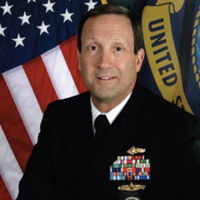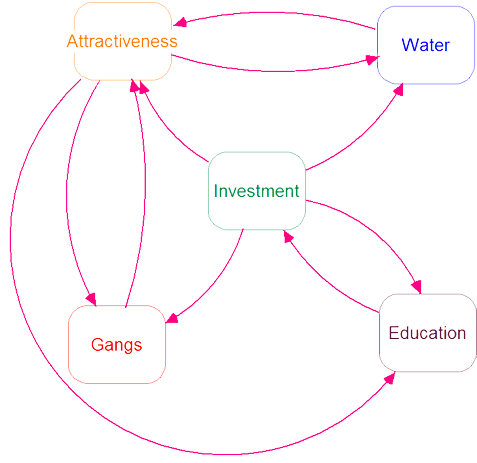The Steinbeck Innovation Project: Applying Systems Thinking and Action Research to Regional Planning
 Captain Wayne Porter, USN
Captain Wayne Porter, USN
While most corners of the U.S. are rebounding from the Great Recession of 2008, Salinas, California’s economy has remained moribund. The state’s water shortage is also a concern for the County-wide
$4.14 billion agricultural industry that serves as the city’s economic foundation. A significant portion of the public school student population is first or second generation Americans; many of
them struggle with English writing skills and cultural differences that discourage their academic success. Community security is threatened by a gang problem. It’s a community in need of an opportunity.
Salinas has everything you need to create a new model for sustainable economic and educational development
The search for an opportunity led the Mayor of Salinas to Captain Wayne Porter, Chair of Systemic Strategy and Complexity, Global Public Policy Academic Group at the Naval Postgraduate School (NPS)
in Monterrey, California. A PhD candidate and Chair for Systemic Strategy and Complexity, Porter had previously served as the Special Assistant for Strategy to Chairman of the Joint Chiefs of Staff,
Admiral Mike Mullen and had been sent to NPS to pursue the application of system science to strategic planning.
Porter recognized the challenges facing Salinas as an opportunity in disguise. “Salinas has everything you need to create a new model for sustainable economic and educational development,” says Porter.
“It has an established industry and a young, available workforce. It has proximity to Silicon Valley where there is technological expertise and capital.”
The city was already at carrying capacity for water usage... It couldn’t build the economy by adding more cultivating acreage
His idea was to develop a regional cluster that would focus on developing and manufacturing the elements of precision agriculture – sensors, robotics, nutrient recovery and filtration systems, water
management and waste management technology. “The city was already at carrying capacity for water usage,” says Porter. “It couldn’t build the economy by adding more cultivating acreage. But it could
attract businesses and jobs that would leverage its agricultural base by developing a skilled, design and manufacturing labor pool with an exportable commodity.” The vision was to address the global
challenges of food and water sustainability through the tools of precision agriculture while providing local opportunity and hope.
Together with the Mayor, Silicon Valley consultant John Hartnett and a small team of community stakeholders, Porter participated in the Steinbeck Innovation Project, a strategic planning and investment
effort that launched the Steinbeck Cluster in December 2012. At the same time, he began the Systems-Thinking-fueled action research that would serve as his dissertation focus.
The systems model runs all five modules over a 25-year period and is initialized with publicly available data
“The Salinas project was perfect for action research and I was fortunate to be embedded in the process,” says Porter. “It allowed me to model socioeconomic, cultural, and physical resource restraints
that you’ll find at a regional, federal, or even worldwide level. And, it was a great opportunity to apply Systems Thinking and strategic planning while helping the community of Salinas and the Central
coast region.”
Using iThink from isee systems, Porter developed five, integrated modules that represent key systems with the project’s strategy. While not intended to be predictive in nature, the system model
provides decision and policy makers an enhanced understanding of potential non-linear behavioral outcomes that could result from the strategy’s integrated structure and feedback mechanisms over time.
The systems model runs all five modules over a 25-year period and is initialized with publicly available data (population, revenue, flow from high school to agriculture technology education,
gang membership, water supply, etc.). The five modules that comprise the model address:
- Investment funds, start-ups, and research activity
- Gang membership and prevention programs
- Education for agricultural technology employment
- Water management
- The Salinas area’s attractiveness to high income earners
“The attractiveness module pulled everything together,” says Porter. “It looks at the ability of Salinas to attract agriculture technology professionals from five neighboring cities as a function of
six factors of community attractiveness: community security, school quality, available services and infrastructure, cost of living, employment opportunities, and water availability. Each factor is
given a weighted score. If the ratio of Salinas to the average score of the five cities is zero on any factor in a given year, it’s not attractive.”
The model has provided several critical insights... At the 19-year mark, according to the model run, projected growth will exceed water availability
Scored attractiveness factors allow Salinas to compare itself to nearby communities and anticipate movement of higher-wage earners. The model also points out the relationships between factors.
“As higher-wage earners move in and business grows, tax revenue increases,” says Porter. “That leads to an improvement in school and service quality and community security. However, the cost of
living also increases, diminishing attractiveness. Water is another balancing loop: as the community grows, commercial and residential consumption draw down the water supply.”
 High-level map of interactions within Salinas
High-level map of interactions within Salinas
“The model has provided several critical insights,” says Porter. “Most of Salinas’ water is drawn from aquifers. At the 19-year mark, according to the model run, projected growth will exceed water
availability. So, the city knows now that it will need a water sustainability solution well before that point. And, the thing that increases the number of sustainable businesses in Salinas is
increasing the percentage of kids that get involved in Ag Tech, science, technology, engineering, and math (STEM).”
The gang membership module shows a decline in gang membership, which then influences several factors in the attractiveness model
The insight about kids’ involvement in STEM has been particularly powerful for planners and investors. “Tailored Ag Tech involvement makes more of a long term difference than increasing financial
investment,” says Porter. “Further, STEM involvement inoculates kids from gang membership.”
Accordingly, the Steinbeck Innovation Foundation is supporting a program called Coder Dojo that gets kids involved in programming when they’re 8-13. By creating job opportunity and reducing the
susceptible pool of 14-24 year olds through early STEM intervention, the gang membership module shows a decline in gang membership, which then influences several factors in the attractiveness model.
There’s no specific recipe for sustainability
“I’ve spent two and a half years looking at industrial clusters and there’s no specific recipe for sustainability,” says Porter. “There is, however, one consistent component that’s essential for
success: an underlying educational system that exposes kids to the information and skills needed to create an adaptable workforce. The Steinbeck Cluster had to address economic development by
building opportunity through education.”
Porter’s work extended beyond modeling the industrial cluster’s impact on the Salinas community. As important, he wanted to understand the impact of supporting the cluster’s development with
strategic planning and System Dynamics. To do that, he interviewed project participants to understand the group’s strategic planning process. Then, he administered a short Likert questionnaire
in which respondents rated aspects of their strategy and planning process. Subjects then interacted with the integrated systems model. They were encouraged to change parameters and note the
impacts of those changes. Finally, the questionnaire was re-administered to note changes in thinking about the strategy and planning process.
If you’re trying to create a new policy, a new process, a new educational model; this is a decision maker’s tool and a great ‘what if’ tool
“It’s so validating to watch the people involved interact with the model,” says Porter. “They really get it for the right reasons. They focus on the feedback mechanisms and understand that
it’s the change in relationship between numbers – not the numbers themselves - that shows key points of influence.”
When Porter shared the model with Bran Fitzgerald, an early Apple employee, high tech entrepreneur, and COO for a small Silicon Valley technology firm, it “blew his mind.” “If you’re trying to
create a new policy, a new process, a new educational model; this is a decision maker’s tool and a great ‘what if’ tool,” says Fitzgerald. “It’s an innovator’s dream.”
To have a tool that is not just easy to use but that brings clarity to how to get to a solution efficiently... you can’t calculate the worth of something like that
A newcomer to Systems Thinking and modeling, Fitzgerald appreciated iThink’s accessibility. “It’s very easy to follow, very interactive,” he said. “When you start working with it, the results
are very clear, which helps you set a course for where you want to go and how you want to get there. In the technology industry, time isn’t just money. Time is important. To have a tool that
is not just easy to use but that brings clarity to how to get to a solution efficiently... you can’t calculate the worth of something like that.”
“I’m really hoping more and more people catch on to the benefits of Systems Thinking and modeling,” says Porter. As he hoped, his model is getting attention from peers at NPS and the Pentagon.
Maybe more important, it’s turning the heads of young Salinas students who will use it to plot their own futures.
“When students see this they become zealots,” he added.